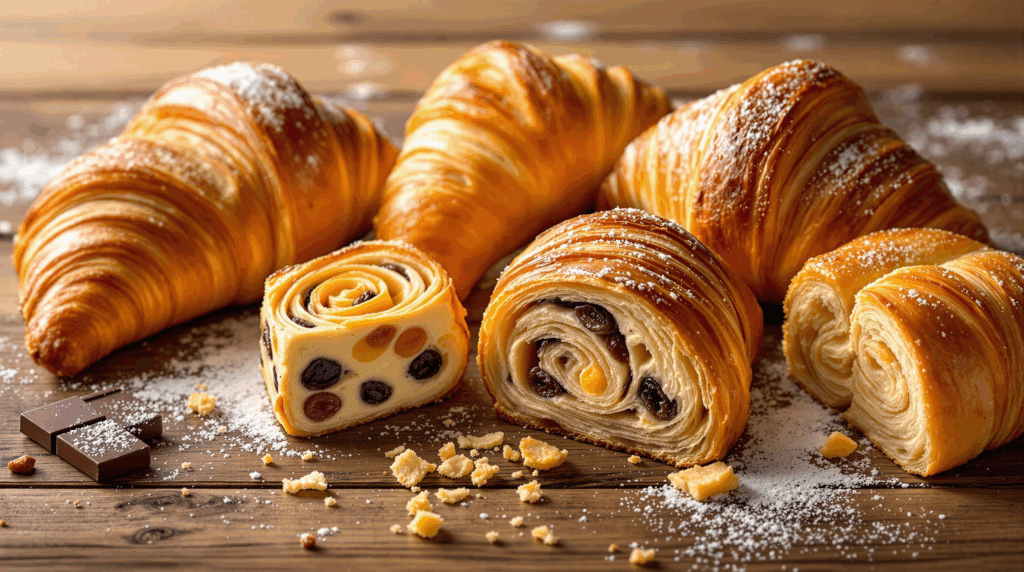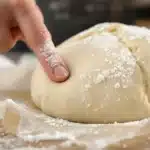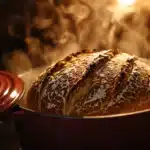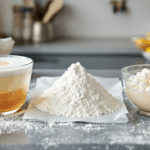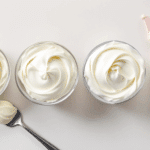When you think of indulgent breakfast pastries, what comes to mind? Perhaps the iconic flaky layers of a croissant, the sweet swirl of a fruit-filled Danish, or the rich, golden, pillowy softness of brioche. These beloved items, along with pain au chocolat, sticky buns, and more, belong to a special category of baked goods known as Viennoiserie. Bridging the gap between simple bread and rich pâtisserie (pastry and cakes), Viennoiserie represents a pinnacle of baking craft, combining yeasted doughs with enrichment and often intricate lamination techniques.
But what exactly defines Viennoiserie, and what makes these pastries so distinctively delicious? For the aspiring pastry baker, understanding this category opens up a world of rewarding techniques and irresistible results. While some items, like croissants, might seem daunting, others like brioche offer a different path to richness. Let’s embark on a “Viennoiserie Voyage” to explore the defining characteristics of these “things of Vienna” and meet some of their most famous and delectable members.
What is Viennoiserie? Bridging Bread and Pastry
Viennoiserie (pronounced roughly “vyen-wahz-uh-REE”) literally translates to “things of Vienna.” The term originated in France in the 19th century when Austrian bakers introduced techniques for richer, laminated yeast doughs to Paris, which were then embraced and refined by French pâtissiers. Today, Viennoiserie refers to a specific category of baked goods characterized by:
- Yeast Leavening: Unlike classic puff pastry (leavened by steam) or most cakes (leavened by chemical agents or egg foams), Viennoiserie relies on yeast for its primary rise, contributing both volume and complex fermentation flavors.
- Enriched Dough: The base dough is almost always enriched with ingredients beyond the basic flour, water, salt, and yeast found in lean breads. Common enrichments include butter, eggs, milk, and sugar, which contribute richness, tenderness, flavor, and color.
- Lamination (Often, Not Always): Many, perhaps most, iconic Viennoiserie items – like croissants, pain au chocolat, and Danish pastries – involve lamination, the meticulous process of creating thin, alternating layers of dough and butter, resulting in a flaky texture. However, some key members, like brioche, are highly enriched but not laminated.
- Texture & Place: Viennoiserie typically occupies a textural space between bread and pastry. It’s often lighter and flakier than most breads but richer and softer than classic puff pastry. These items are traditionally enjoyed for breakfast or as snacks (le goûter), rather than as formal plated desserts (though they certainly can be!).
Essentially, Viennoiserie takes the principles of yeast fermentation found in bread making and elevates them through enrichment and, frequently, the delicate art of lamination.
Star Player #1: Danish Pastry (The Versatile Spiral and Beyond)
A quintessential example of laminated Viennoiserie, Danish pastry offers endless variations in shape and filling.
- What It Is: A sweet, yeast-leavened pastry made from laminated dough, characterized by its flaky layers, tender crumb, and typically sweet fillings or toppings.
- The Dough: The dough for Danish pastry is very similar to croissant dough but is often slightly more enriched, potentially containing more sugar, eggs, or sometimes spices like cardamom for extra flavor. It undergoes the lamination process: an enriched détrempe (base dough) encases a beurrage (butter block), and the packet is repeatedly rolled, folded, and chilled (typically 3 “single turns”) to create those signature buttery layers.
- Shapes and Fillings Galore: Danish pastry is a canvas for creativity!
- Common Shapes: Pinwheels (with filling exposed in corners), envelopes or pockets (filling enclosed), braids, combs, spirals (known as “snails” or escargots).
- Classic Fillings/Toppings: Sweetened cream cheese filling, almond paste (frangipane or remonce), fruit preserves or cooked fruit compotes, fresh fruit arranged before or after baking, chopped nuts, chocolate chips or drizzles, streusel topping, simple sugar glazes, or fondant icing.
- The Process: It’s a multi-step journey involving making the enriched détrempe, allowing it to bulk ferment (first rise), laminating it carefully with high-quality butter, chilling thoroughly between turns, rolling out the finished dough, cutting and shaping it around fillings, allowing the shaped pastries a final proof (second rise, crucial for yeast activity), applying an egg wash for color and shine, and finally baking until golden brown and flaky.
- Key Characteristics: The delightful contrast of crisp, flaky, buttery layers with a slightly soft, enriched interior crumb, all complemented by the sweetness or tanginess of the chosen filling or topping.
Star Player #2: Brioche (The Rich & Pillowy Loaf/Roll)
While croissants and Danishes showcase laminated Viennoiserie, Brioche is the star example of a highly enriched, non-laminated member of the family. It’s celebrated for its incredibly rich flavor and light, airy, almost cloud-like texture.
- What It Is: A classic French bread made from a yeast dough that is exceptionally rich in butter and eggs.
- The Dough: Brioche dough contains a very high percentage of fat (butter) and eggs relative to the flour content, along with milk or water, sugar, yeast, and salt. This high level of enrichment interferes significantly with gluten development, making the dough very soft, sticky, and sometimes challenging to handle. Proper development often requires long, slow mixing (using a stand mixer is highly recommended) to build sufficient gluten structure without overheating the dough (which could melt the butter). A period of cold fermentation (retardation) in the refrigerator is almost always employed after bulk fermentation; this chills and firms the butter within the dough, making the soft dough much easier to handle and shape.
- Classic Shapes:
- Brioche à tête (“Brioche with a head”): The iconic shape, featuring a large ball of dough topped with a smaller ball, baked in a traditional fluted, flared brioche tin.
- Brioche Nanterre: Several small balls of dough placed side-by-side in a standard loaf pan, fusing together during proofing and baking.
- Other Forms: Individual rolls, plaited loaves, rings, or even used as the base for sweet or savory dishes like French toast, bread pudding, or burger buns.
- The Process: Requires careful mixing to fully incorporate the large amount of butter (often added gradually to the developed dough), sufficient bulk fermentation (often including cold retardation), skillful shaping of the chilled dough, a final proof, a generous egg wash (key for its characteristic deep golden, shiny crust), and baking until richly colored and cooked through.
- Key Characteristics: A deep golden-brown, often shiny crust gives way to an exceptionally soft, tender, fine-grained crumb with a distinct yellow hue (from the eggs and butter). The flavor is intensely rich and buttery, with a subtle sweetness.
Other Notable Stops on the Viennoiserie Voyage
Beyond Danishes and Brioche, the Viennoiserie world includes other delights:
- Croissant / Pain au Chocolat: Perhaps the most famous examples. Made from laminated, yeasted dough, differing slightly from Danish dough (often less sweet, sometimes different lamination). Pain au chocolat simply encases sticks of dark chocolate within the croissant dough before shaping and baking.
- Kouign-Amann: (Pronounced roughly “kween ah-MAHN”) A decadent pastry originating from Brittany, France. It uses a laminated dough similar to croissant dough, but with layers of granulated sugar (and often more butter) incorporated during the folding process. As it bakes, the butter melts and the sugar caramelizes, creating an incredibly rich, buttery, flaky, sticky, caramelized exterior and a tender interior. A true indulgence!
- Pain aux Raisins (or Escargot): A spiral of laminated yeasted dough (often Danish or croissant dough) spread with pastry cream and sprinkled with raisins before being rolled up, sliced, proofed, and baked.
- Related “Sweet Rolls”: While perhaps influenced more by North American traditions, pastries like Cinnamon Rolls and Sticky Buns, made from enriched, yeasted dough (which may or may not be lightly laminated) and featuring sweet fillings and glazes, share many characteristics and principles with Viennoiserie.
Tips for Your Viennoiserie Journey
Embarking on Viennoiserie baking requires care and attention to detail:
- Quality Ingredients: Use the best ingredients you can, especially high-fat (European-style) unsalted butter for laminated items, as its flavor and plasticity are crucial. Good quality flour and fresh eggs also make a difference.
- Temperature is Paramount: Success, especially with laminated doughs, hinges on temperature control. Keep your butter pliable but cold during lamination. Ensure adequate chilling between turns. Control proofing temperatures to manage yeast activity. For brioche, keep the dough cool during mixing to prevent the butter from melting out.
- Patience is Essential: Viennoiserie is not rushed baking. It involves multiple stages – fermentation, chilling, lamination turns, shaping, proofing – often spread over hours or even days (if using cold retardation). Embrace the process.
- Master Basics First: Before tackling complex lamination or high-fat brioche, ensure you’re comfortable with basic yeast dough principles, enriched dough handling, and perhaps simpler shaping techniques.
- Follow Reliable Recipes: Viennoiserie relies on carefully balanced formulas and specific techniques. When starting, choose detailed recipes from trusted sources and follow the instructions meticulously, paying close attention to temperatures, timings, and visual cues.
Conclusion: The Rewarding World Between Bread and Pastry
Viennoiserie represents a delicious and technically fascinating intersection of bread making and pastry arts. By incorporating the richness of butter, eggs, and sugar into yeast-leavened doughs, and often employing the intricate art of lamination, bakers create pastries with unique textures – flaky, tender, soft, rich – and complex flavors derived from both fermentation and enrichment.
From the versatile Danish pastry with its myriad shapes and fillings to the unbelievably rich and pillowy brioche, exploring Viennoiserie offers a deeply rewarding challenge for the aspiring pastry baker. While requiring patience, precision, and careful temperature control, the results – golden, fragrant, buttery, and utterly delicious pastries perfect for breakfast, brunch, or a special treat – are undoubtedly worth the journey. So, dare to embark on your own Viennoiserie voyage!

